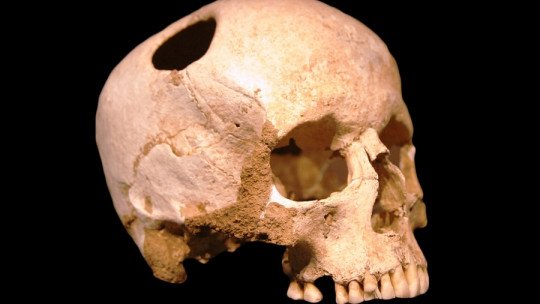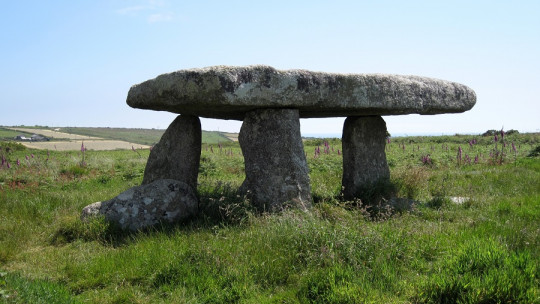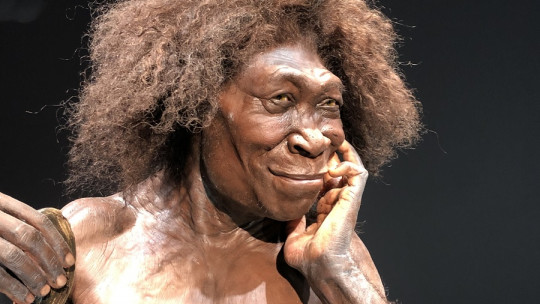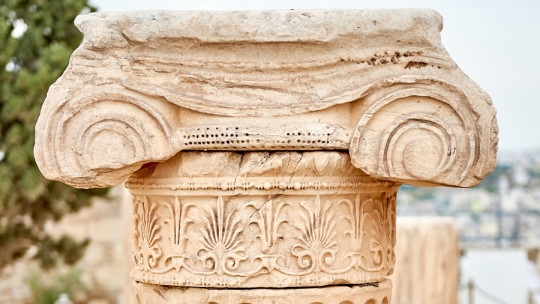Trepanation is an ancient practice with uncertain origins It consists of drilling the skull bone with a tool and extracting it, and its name comes from the word trephine, which means perforator in Greek.
Archaeologists have found numerous testimonies of this practice dating back to the Neolithic, although the most curious thing is that pierced skulls have been found in areas of the planet completely remote from each other and which, of course, had not exchanged any knowledge.
All this raises a series of questions: Why did our ancestors pierce their skulls? What objective were they pursuing with this? Was it a really dangerous practice? Was it due to a ritual, or was it one of the first manifestations of surgical medicine that existed?
Why did our ancestors perform trepanations in the skull?
Trepanned skulls have been found in places such as Japan, Germany, the Iberian Peninsula, Mexico and Chile. These are territories that are too far away, which could not share any type of practice or knowledge, which adds even more mystery to the issue. Was there perhaps an ancestral practice in the first groups of humans, which then remained once the various communities expanded across the land?
This theory does not seem plausible, since The first evidence of cranial drilling dates back to the Neolithic a dating that is too “close” in time, in which the human being was already spread throughout the globe.
Specifically, the oldest vestiges date from approximately 8,000 BC, in the middle of the Mesolithic, the period that serves as a transition between the Paleolithic and the Neolithic, and were discovered in North Africa, Portugal and Ukraine.
Does this mean that the complete absence of trepanning in pre-Mesolithic remains means that the practice was born 10,000 years ago? Or perhaps it was much older, but no remains have been found yet? And, above all, why did trepanation arise?
What is trepanation?
First of all, let’s properly address what trepanation is. It is an operation that consists of removing the scalp and then drilling a hole in the skull bone. Then the wound is cleaned and bandaged.
At the moment, This practice is still carried out in the medical field, and is called craniotomy However, just as it currently has an exclusively medicinal purpose, it is unknown why our prehistoric ancestors did it.
After knowing what trepanation consists of, another of the questions we inevitably ask ourselves is: was this practice safe? Well, against all odds, it was much more so than we thought. First, as Miguel Botella, director of the Department of Physical Anthropology at the University of Granada, maintains, the brain and the meninges that protect it are painless, so it does not seem that this strange practice produced excessive pain.
Second, It is estimated that in the Neolithic, 30% of those intervened survived which, according to Botella, is not a high mortality rate, especially when compared to the survival rate in trepanations in ancient and medieval times, which was only 1%.
Prehistoric trepanation, a dangerous technique?
This survival rate rises to 80% according to other researchers. Apparently, Neolithic humans learned, through trial and error, how to properly pierce the skull without touching the membrane that protects the brain. On the other hand, and again according to Miguel Botella, the instruments used in prehistoric trepanations, made with flint points, were much more hygienic than the metal instruments with which the skull was opened in Rome and in the Middle Ages.
Archaeologists have observed that, In many trepanned skulls, a renewal of the bone is seen around the hole , indicating that the individual survived the operation. In fact, this “new bone” is an infallible indicator to detect whether the trepanation was a success or not. On the other hand, most deaths occurred from infection, and not from the effects of the trepanation itself.
Trepanations: rituals or medical remedies?
And we come to the crux of the matter. What was the purpose of the trepanations? Were they actually medical remedies to alleviate illnesses, or were they rather sacred rituals? Or maybe a mix of both?
Elena Batieva, an anthropologist at the Southern Federal University (Rostov, Russia), led the excavations that found a series of trepanned skulls in Russia that are about 5,000 years old. Batieva observed that all the perforations were executed in the same place, the obelion a point located on the top of the skull.
It is not the best place to start a trepanation, since the blood from the brain converges in the obelion before going out to the rest of the body. The find was, to say the least, intriguing.
The most mysterious thing was, however, that the skulls showed no sign of any injury, even before being trepanned, so Batieva concluded that the practice had been performed on healthy people, which ruled out an operation for medical purposes.
A few years later, another anthropologist, Julia Gresky, found, also in Russia, other apparently healthy skulls that had been drilled at exactly the same point. The coincidence of the trepanned location and the fact that all these skulls were located in the same area led Batieva and Gresky to think that southern Russia could have been, during Prehistory, a center linked to religious practices, which included clambering.
Is this definitive proof that prehistoric trepanations had religious purposes? Yes and no. Without ruling out the possibility that this practice was carried out for ritual purposes, this does not exclude that it coexisted with a more “medical” practice, which aimed to remove brain tumors, drain fluids, or cure migraines and mental illnesses
However, Miguel Botella does not agree. The anthropologist maintains that it is completely impossible for our ancestors to know that certain disorders and diseases are related to tumors in the brain, since even in the time of Aristotle it was still believed that the center of activities was the heart. The Egyptians, remember, removed the brain during mummification and did not preserve it along with the other organs, which gives us an idea of the value that ancient cultures gave to this organ.
Conclusions
Unfortunately, we do not have conclusive evidence to shed light on the issue. If we look at the archaeological remains, it is possible that for a long time the ritual objective coexisted with the curative objective when performing trepanations.
It is also possible that, when faced with a case of epilepsy or mental disorder, our ancestors sensed that the “problem” was in the head, although perhaps they attributed it to spirits or evil forces and wanted to make them “march” through the hole in the skull. If the problem was actually physically located in the brain (like a fluid buildup, for example), the solution could have effectively cured the “possessed.” For now, there is still much to investigate and many questions to answer.









